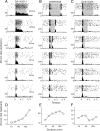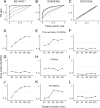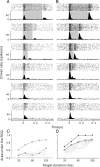Neural and behavioral discrimination of sound duration by cats
- PMID: 20016079
- PMCID: PMC6666173
- DOI: 10.1523/JNEUROSCI.2442-09.2009
Neural and behavioral discrimination of sound duration by cats
Abstract
Sound duration is important for distinguishing auditory object. Previous studies on the neural representation of duration have usually lacked psychophysical data obtained from the same species; hence, the correspondence between neural and behavioral discrimination of duration remains obscure. We addressed this issue in cats by using the signal detection theory to investigate both neural activities in the primary auditory cortex (A1) and the cat's behavioral performance. We found that 320 ms duration can be well discriminated from 10 ms duration by some A1 neurons with specific response patterns: sustained response extended proportionally with the increase of stimulus duration and the On-Off response synchronizing stimulus onset and offset. Neurons with only On response cannot discriminate duration. The discrimination performance of both sustained and On-Off responses deteriorated as the target duration decreased from 320 to 20 ms and the percentage of discriminative neurons (correct rate >0.75) decreased from 40 to 2%. Compared with the psychophysical results, we found that the psychometric functions of cats well matched the neurometric functions of most sustained-response neurons and a small number of On-Off-response neurons. Pooling the spikes of multiple units improved neural discrimination, which may be attributable to the salience (noise reduction) of the responses in pooled data. Our results suggest that the sustained and Off responses of A1 neurons underlie the duration discrimination behavior of cats.
Figures









References
-
- Brand A, Urban R, Grothe B. Duration tuning in the mouse auditory midbrain. J Neurophysiol. 2000;84:1790–1799. - PubMed
-
- Britten KH, Newsome WT, Shadlen MN, Celebrini S, Movshon JA. A relationship between behavioral choice and the visual responses of neurons in macaque MT. Vis Neurosci. 1996;13:87–100. - PubMed
-
- Calford MB, Webster WR. Auditory representation within principal division of cat medial geniculate body: an electrophysiology study. J Neurophysiol. 1981;45:1013–1028. - PubMed
-
- Casseday JH, Ehrlich D, Covey E. Neural tuning for sound duration: role of inhibitory mechanisms in the inferior colliculus. Science. 1994;264:847–850. - PubMed
Publication types
MeSH terms
LinkOut - more resources
Full Text Sources
Miscellaneous
